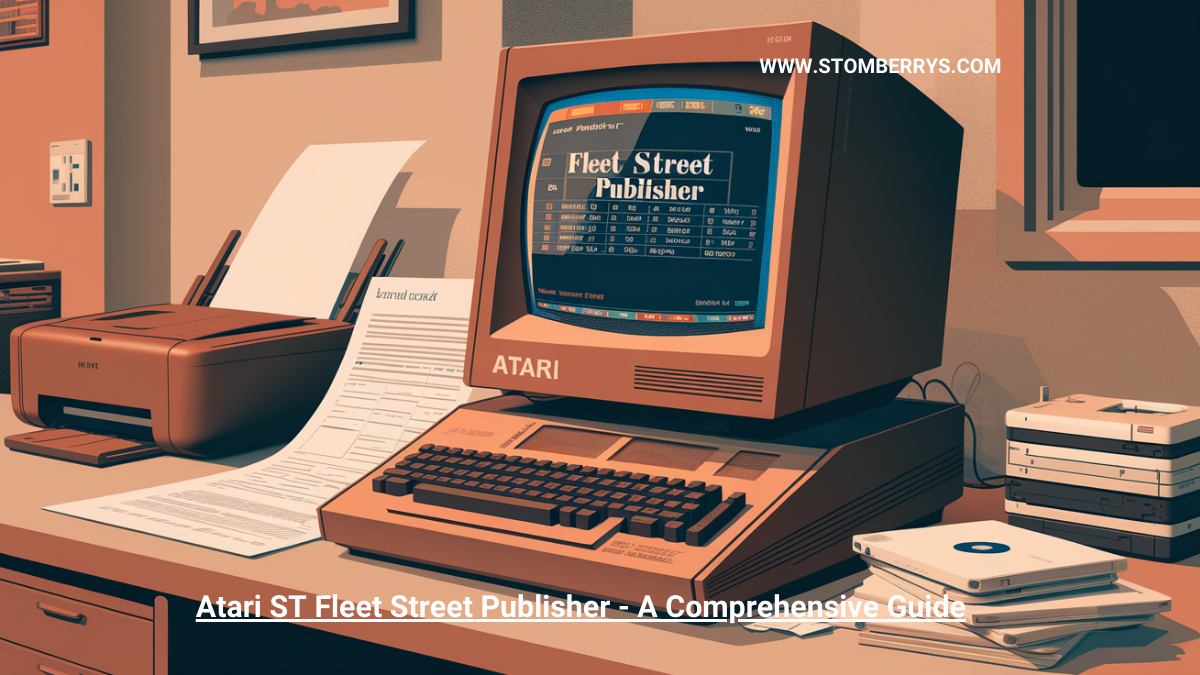1. Introduction
What is Atari ST Fleet Street Publisher?
Atari ST Fleet Street Publisher was a game-changing piece of desktop publishing (DTP) software released in the late 1980s, specifically for the Atari ST personal computer. Developed to provide affordable DTP capabilities to small businesses, hobbyists, and individuals, it allowed users to create professional-grade documents, brochures, newsletters, and more—right from the comfort of their homes or small offices.
“Atari ST Fleet Street Publisher” was a desktop publishing software created for the Atari ST, emerging from the vibrant Atari ecosystem in the late 1980s to facilitate affordable desktop publishing.
While many modern users have never encountered Fleet Street Publisher, its influence is still felt today in modern DTP and graphic design software. Despite being overshadowed by competitors like Aldus PageMaker and QuarkXPress, Fleet Street Publisher became a beloved tool among Atari ST users who appreciated its accessibility and affordability.
Why Is It Important Today?
Fleet Street Publisher represents a pivotal moment in computing history when desktop publishing became accessible to everyday users. As a result, it democratized the ability to create professional documents, which previously required expensive and complex equipment. Its relevance lies in the legacy it left on the publishing industry and how it paved the way for today’s user-friendly software.
2. The Atari ST: A Revolutionary Platform
Background on Atari ST
The Atari ST was a line of home computers released in the mid-1980s by Atari Corporation. Known for its advanced graphical capabilities and MIDI support, the Atari ST quickly became popular with musicians, graphic designers, and home users. Introduced in 1985, the “ST” stood for “Sixteen/Thirty-two,” referring to the machine’s 16-bit external bus and 32-bit internal processing.
Technical Capabilities of Atari ST
The Atari ST offered:
- M68000 Motorola Processor: Powered by a 32-bit CPU that allowed for multitasking and efficient graphic processing.
- Graphics and Sound: Its high-resolution monochrome monitor and rich sound capabilities appealed to creative professionals.
- MIDI Ports: The inclusion of built-in MIDI ports made it a favorite among musicians.
- Affordable Pricing: Priced lower than many competitors, the Atari ST was an attractive option for hobbyists and professionals alike.
The ST’s Appeal to Creative Professionals
The ST’s unique combination of high performance and affordability made it an appealing platform for creative users in fields such as music, graphic design, and desktop publishing. It was the perfect environment for software like Fleet Street Publisher to flourish, as the ST community was already attuned to producing creative content.
3. Birth of Fleet Street Publisher
Development of Fleet Street Publisher
Fleet Street Publisher was developed by Mirrorsoft, a British software company known for creating productivity and gaming software for a variety of platforms, including the Atari ST. Released in the late 1980s, the software was designed to allow users to take full advantage of the Atari ST’s high-resolution graphical capabilities.
The Role of Desktop Publishing in the 1980s
The 1980s was a decade of technological innovation, especially in the publishing industry. Before desktop publishing software like Fleet Street Publisher, creating professional-quality print materials required costly typesetting machines and layout tools. Software like Fleet Street Publisher offered an affordable alternative, allowing users to create documents, newsletters, and even magazines.
A Competitive Market: How Fleet Street Publisher Stood Out
Fleet Street Publisher entered a growing market of DTP software, competing against programs like Aldus PageMaker and QuarkXPress. However, its lower cost and user-friendly interface made it a favorite for Atari ST users. By offering a feature-rich, affordable option, Fleet Street Publisher allowed small businesses, schools, and even individuals to produce professional-looking printed material without breaking the bank.
4. Features of Fleet Street Publisher
Key Features
Fleet Street Publisher was packed with features that made it a formidable desktop publishing tool:
- WYSIWYG Interface: “What You See Is What You Get” allowed users to design layouts that would appear exactly as they would print.
- Multiple Font Support: A variety of fonts and text styles could be used to create visually appealing documents.
- Page Layout Tools: Fleet Street Publisher included advanced page layout tools, such as text wrap, layering, and column formatting.
- Graphic Support: Users could import and manipulate basic graphics, which was a groundbreaking feature at the time.
- Spell Check and Grammar Tools: For professional-grade publishing, the software also featured built-in spell check capabilities.
User Interface
Fleet Street Publisher was designed with simplicity in mind, making it accessible even for users who were new to desktop publishing. The interface was intuitive, with icons and menus that guided users through the creation and layout process.
File Formats and Compatibility
While limited in comparison to today’s standards, Fleet Street Publisher supported file formats compatible with most printers of the time. Users could export files in various formats suitable for commercial printing.
Printing and Output Capabilities
One of the software’s major selling points was its ability to work with Atari ST-compatible printers, allowing users to print high-quality documents from home. It supported a wide range of printers and was optimized for the Atari ST’s capabilities, ensuring that printed documents mirrored on-screen layouts.
5. Fleet Street Publisher’s Impact
Revolutionizing Desktop Publishing for Atari ST Users
Fleet Street Publisher played a significant role in the democratization of desktop publishing. Previously, creating high-quality print materials was expensive and complex. Fleet Street Publisher made it possible for everyday users to engage in professional-quality publishing at a fraction of the cost.
Affordability and Accessibility: Democratizing Publishing
What set Fleet Street Publisher apart from many competitors was its affordability. Paired with the relatively low cost of the Atari ST, this software gave people access to desktop publishing capabilities that had previously been reserved for large corporations or publishing houses.
How It Shaped the Future of DTP Software
Fleet Street Publisher wasn’t just a product of its time; it laid the groundwork for future developments in desktop publishing software. Its emphasis on user-friendly design and affordability influenced later DTP programs, which aimed to reach a broader audience.
6. Comparison to Contemporary DTP Software
Fleet Street Publisher vs. Competitors
While Aldus PageMaker and QuarkXPress were the industry giants, Fleet Street Publisher had a niche audience. Here’s how it compared:
- Cost: Fleet Street Publisher was more affordable than QuarkXPress, making it accessible to smaller businesses.
- Interface: It was simpler to use than some of its more professional competitors.
- Capabilities: While not as feature-rich as PageMaker or QuarkXPress, Fleet Street Publisher offered more than enough functionality for home users and small businesses.
Advantages and Limitations
While Fleet Street Publisher was accessible and powerful for its time, it had some limitations:
- Limited Graphic Support: More advanced graphic handling was available on QuarkXPress.
- Printing Constraints: Only certain printers could fully utilize the software’s capabilities.
7. User Experience and Reviews
Testimonials from Atari ST Users
Many Atari ST enthusiasts have fond memories of Fleet Street Publisher. It was praised for its simplicity and power at a time when desktop publishing was still an emerging field. Users in the 1980s loved the ability to create polished materials without needing a professional design background.
Real-Life Applications in the 1980s and 1990s
From school newsletters to local newspapers, Fleet Street Publisher was used by various small organizations to produce professional-quality publications. It was especially popular among hobbyists and small business owners.
8. Fleet Street Publisher in Today’s Digital World
Legacy of Fleet Street Publisher
Although Fleet Street Publisher is no longer in use, its legacy lives on in today’s desktop publishing tools. Modern software like Adobe InDesign and Microsoft Publisher owe part of their ease of use to the trail blazed by early DTP programs like Fleet Street Publisher.
Relevance to
Modern DTP and Graphic Design
Fleet Street Publisher helped establish many conventions that are still in use today, such as WYSIWYG editing and flexible page layouts. These concepts continue to be fundamental in graphic design and DTP.
9. Atari ST Fleet Street Publisher’s Legacy in the U.S. Market
The Atari ST’s Popularity in the USA
The Atari ST gained moderate popularity in the U.S., particularly among creatives. Musicians, designers, and educators appreciated the ST’s power and flexibility. Fleet Street Publisher, while not as well-known as some U.S.-developed software, found its niche with ST users who needed a powerful yet affordable DTP solution.
Fleet Street Publisher’s Impact on American Desktop Publishing
In the U.S., where desktop publishing was gaining ground, Fleet Street Publisher allowed smaller organizations and individuals to compete with larger, well-funded counterparts by providing affordable, professional-quality publishing tools.
10. FAQs: Everything You Need to Know
What was Atari ST Fleet Street Publisher used for?
It was used for desktop publishing, allowing users to create professional-quality printed documents, such as brochures, newsletters, and flyers.
When was Fleet Street Publisher released?
Fleet Street Publisher was released in the late 1980s for the Atari ST platform.
Why was Fleet Street Publisher popular?
It was popular due to its affordability, user-friendly interface, and ability to produce professional-quality documents on the Atari ST.
What are the alternatives to Fleet Street Publisher?
During its time, competitors included Aldus PageMaker and QuarkXPress. Today, modern alternatives include Adobe InDesign and Microsoft Publisher.
Is Fleet Street Publisher still available?
Fleet Street Publisher is no longer available or in production, but its legacy lives on in modern desktop publishing software.





